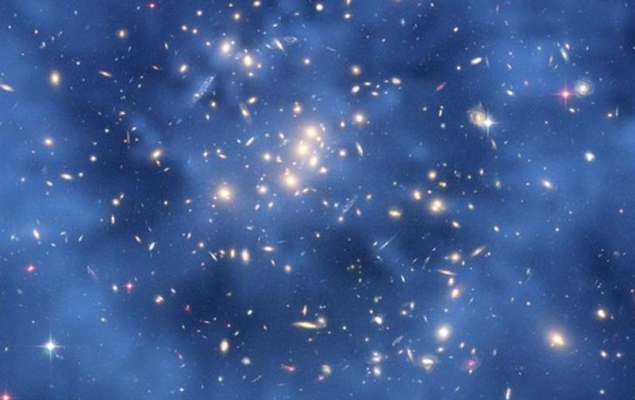- Home
- Others
- Others News
- Scientists close to solving 'dark matter' mystery
Scientists close to solving 'dark matter' mystery

A final identification of what makes up the enigmatic material would solve one of the biggest mysteries in physics and open up new investigations into the possibility of multiple universes and other areas, said researchers.
Members of an international team had picked up what might be the first physical trace left by dark matter while studying cosmic rays recorded on the International Space Station, said the head of the Europe- and U.S.-based research project Samuel Ting.
He told a packed seminar at the CERN research centre, near Geneva, the team had found a surge of positron particles that might have come from dark matter.
In the coming months, he said, the CERN-built AMS particle detector on the space station "will be able to tell us conclusively whether these positrons are a signal for dark matter or if they have some other origin".
Dark matter, once the stuff of science fiction, "is one of the most important mysteries of physics today," Ting, a professor at theMassachusetts Institute of Technology and 1976 Nobel physics prize winner, has written.
Sometimes called the sculptor of the universe's millions of galaxies because of the way its gravity shapes their formation, its existence has long been recognised because of the way it pushes visible stars and planets around.
But efforts in laboratories on earth and in deep underground caverns to find concrete evidence that it is there, and to establish what it is, have so far proven fruitless.
Ting said it was also possible the surges came from pulsars - rotating neutron stars that emit a pulsing radiation.
But CERN physicist Pauline Gagnon told Reuters after hearing Ting that the precision of the AMS could make it possible "to get a first hold on dark matter really soon".
"That would be terrific, like discovering a completely new continent. It would really open the door to a whole new world," said Gagnon, a Canadian physicist on ATLAS, one of the two CERN teams that believe they found evidence of the elusive Higgs particle in the centre's Large Hadron Collider.
New physics
John Conway, a physics professor from the University of California, Davis, working at CERN, said a confirmed discovery would push scientists into uncharted realms of research.
He said fresh insights could be gained into super-symmetry, a theory that says the current known 17 elementary particles have heavier but invisible counterparts, and dimensions beyond the currently known length, breadth and height, and time.
Other scientists, especially cosmologists now trying to peer back beyond the Big Bang 13.8 billion years ago, suggest identification of dark matter could give new clues to whether the universe itself is alone or one of many.
New research could start at CERN's Large Hadron Collider when the vast machine resumes operations in early 2015.
The huge subterranean complex running under the Franco-Swiss border at the foot of the Jura mountains was shut down in February to double its power and multiply the millions of "mini-Big Bang" particle collisions it can stage daily.
Until last week, dark matter was thought to make up around 24 percent of the universe, with normal matter - galaxies, stars and planets - accounting for about 4.5 percent.
But then the European Space Agency's Planck satellite team reported that mapping of echoes of the early cosmos showed dark matter made up 26.8 percent and ordinary matter 4.9 percent - together the total of the material of the universe.
The dominant constituent is the non-material "dark energy", as mysterious as dark matter and believed to be the driver of cosmic expansion.
© Thomson Reuters 2013
Get your daily dose of tech news, reviews, and insights, in under 80 characters on Gadgets 360 Turbo. Connect with fellow tech lovers on our Forum. Follow us on X, Facebook, WhatsApp, Threads and Google News for instant updates. Catch all the action on our YouTube channel.
Related Stories
- Samsung Galaxy Unpacked 2025
- ChatGPT
- Redmi Note 14 Pro+
- iPhone 16
- Apple Vision Pro
- Oneplus 12
- OnePlus Nord CE 3 Lite 5G
- iPhone 13
- Xiaomi 14 Pro
- Oppo Find N3
- Tecno Spark Go (2023)
- Realme V30
- Best Phones Under 25000
- Samsung Galaxy S24 Series
- Cryptocurrency
- iQoo 12
- Samsung Galaxy S24 Ultra
- Giottus
- Samsung Galaxy Z Flip 5
- Apple 'Scary Fast'
- Housefull 5
- GoPro Hero 12 Black Review
- Invincible Season 2
- JioGlass
- HD Ready TV
- Laptop Under 50000
- Smartwatch Under 10000
- Latest Mobile Phones
- Compare Phones
- Honor Win RT
- Honor Win
- Xiaomi 17 Ultra Leica Edition
- Xiaomi 17 Ultra
- Huawei Nova 15
- Huawei Nova 15 Pro
- Huawei Nova 15 Ultra
- OnePlus 15R
- Asus ProArt P16
- MacBook Pro 14-inch (M5, 2025)
- OPPO Pad Air 5
- Huawei MatePad 11.5 (2026)
- Xiaomi Watch 5
- Huawei Watch 10th Anniversary Edition
- Acerpure Nitro Z Series 100-inch QLED TV
- Samsung 43 Inch LED Ultra HD (4K) Smart TV (UA43UE81AFULXL)
- Asus ROG Ally
- Nintendo Switch Lite
- Haier 1.6 Ton 5 Star Inverter Split AC (HSU19G-MZAID5BN-INV)
- Haier 1.6 Ton 5 Star Inverter Split AC (HSU19G-MZAIM5BN-INV)

















